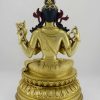Our masterpiece Chenrezig statue is inseparable from Avalokiteshvara the “Bodhisattva of Compassion”. As Buddhism evolved out of India, iconic Buddhist figures met with different interpretations. As a result, when Buddhism was embraced in Tibet, Avalokiteshvara became Chenrezig. Nonetheless, these two deities are one in the same and Chenrezig hears the suffering of all sentient life.
Masterpiece Chenrezig Statue Features
Our Chenrezig statue is elaborately decorated with the crown and jewels of a bodhisattva. At the request of the buyer, we will be happy to embellish the crown and jewels of this statue with red coral and turquoise stones before delivery. This is done as a complementary service and there is no extra charges.
Devotees will be inspired because Chenrezig is depicted holding the “citamani” jewel clasped between his hands in front of his chest. This special attribute is believed by Tibetan Buddhists to appear in whatever form they are wishing for.
The deity sits in a full lotus pose on a double lotus pedestal. Also, known as the “vajra pose” this indicates that Chenrezig sits on a foundation of indestructible virtue. This assumption can be made because vajra is a Sanskrit word that translates as “diamond or thunderbolt” in English.
In his upper right hand he holds the mala beads at shoulder level. Chenrezig is eternally repeating his mantra “Om Mani Padme Hum” and encourages the same dedicated practice from all devotees. Additionally, he is holding the lotus flower in his upper left hand which symbolizes the transcendence of samsara. Like the lotus flower, devotees are encouraged to rise out of the sea of suffering and blossom in the pure air. Click here to learn more about the Avalokiteshvara symbols.










